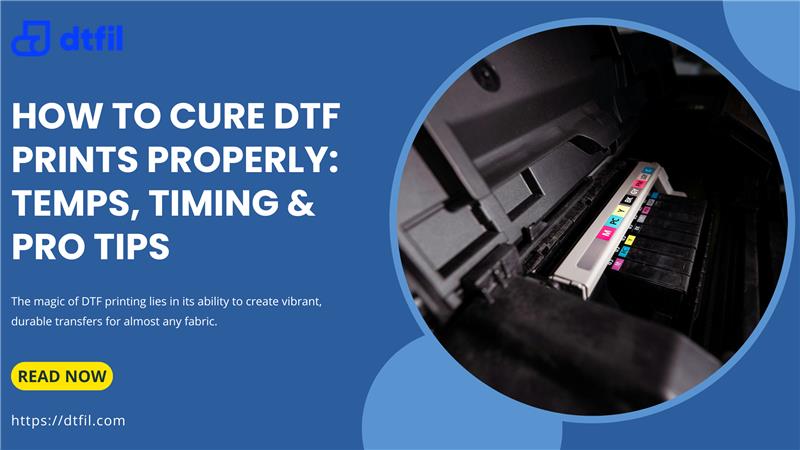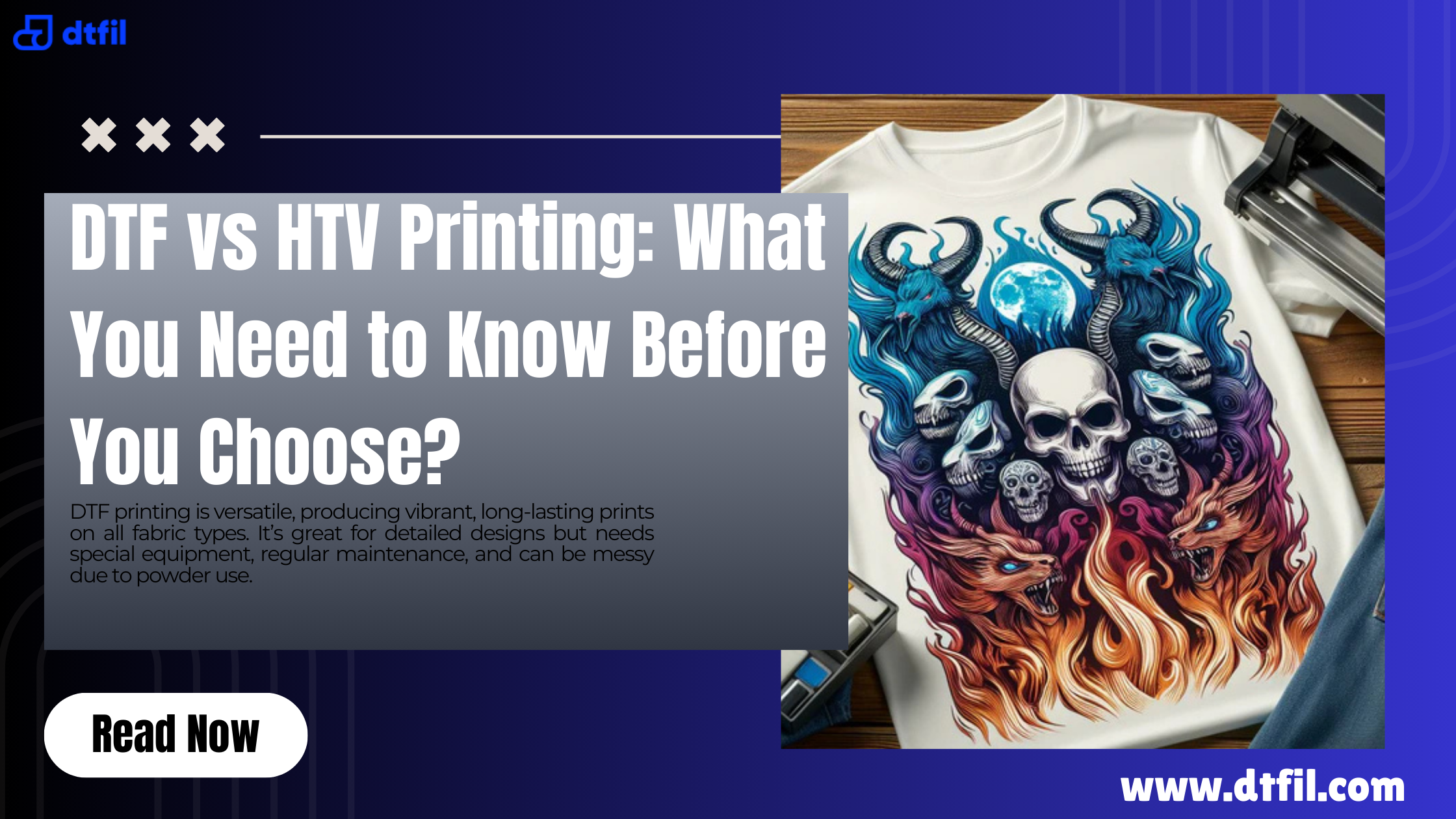DTF printing is flexible; it may be used on a range of materials with vibrant, long-lasting colors. DTG printing offers excellent detail and a soft feel but is best for cotton. Although screen printing has limited color options, it is incredibly durable and cost-effective for big volumes. Sublimation is durable with a soft feel but only works on polyester and light fabrics.
In the world of custom printing, several methods vie for attention: Direct-to-Film (DTF), Direct-to-Garment (DTG), screen printing, and sublimation. Each has its unique strengths and weaknesses.
This article will explore DTF vs DTG printing, DTF vs screen printing, and sublimation to help you choose the best method for your needs.
What is printing with DTF?
Printing designs directly onto a specialized film and then transferring them to fabric is a novel process known as "direct-to-film" (DTF) printing. This technique is well-liked for complex patterns because it provides brilliant colors and superb detail.
Advantages of DTF Printing
- Versatility: The versatility of DTF printing allows it to be used in a wide range of materials, such as mixes, cotton, and polyester.
- Durability: Prints are extremely durable, withstanding fading and cracking over time.
- Color Quality: Offers bright and vivid colors.
Disadvantages of DTF Printing
- Cost: Initial setup can be expensive.
- Complexity: Requires specific equipment and materials.
Also Read: Direct-to-Film (DTF) Printing - What are the Pros and Cons?
DTF vs DTG Printing
In direct-to-garment (DTG) printing, ink is sprayed onto the fabric directly, where it is subsequently absorbed by the fibers.
Advantages of DTG Printing
- Detail: Excellent for intricate and colorful designs.
- Softness: Gives the fabric a velvety texture.
Disadvantages of DTG Printing
- Fabric Limitations: Works best on 100% cotton.
- Durability: Less durable compared to DTF.
DTF vs DTG: Key Differences
- Fabric Compatibility: DTF works on a wider range of fabrics.
- Durability: DTF prints tend to last longer.
- Color Vibrancy: Both offer vibrant colors, but DTF has a slight edge.
Also Read: DTF Heat Press Safety: Essential Guidelines & Tips
DTF vs Screen Printing
In screen printing, ink is applied to cloth by pushing it through a mesh stencil.
Advantages of Screen Printing
- Cost-Effective: Affordable in big quantities.
- Durability: Extremely durable and long-lasting.
Disadvantages of Screen Printing
- Setup Time: Requires significant setup time.
- Color Limitations: Limited to fewer colors per design.
DTF vs Screen Printing: Key Differences
- Setup and Efficiency: Screen printing is cost-effective for bulk orders; DTF is better for small batches.
- Color and Detail: DTF offers more detail and color options.

DTF vs Sublimation Printing
Through the use of heat, dye is transferred into cloth during sublimation printing, permanently bonding with the fibers.
Advantages of Sublimation Printing
- Durability: Extremely durable with no cracking or fading.
- Soft Feel: The ink sinks into the fabric, giving it a velvety texture.
Disadvantages of Sublimation Printing
- Fabric Limitation: This product is limited to polyester and light-colored textiles.
- Color Limitation: Avoid using dark-colored textiles.
DTF vs Sublimation: Key Differences
- Fabric Compatibility: DTF works on more fabric types.
- Color Options: Sublimation is limited to light fabrics, while DTF can handle dark and light fabrics.
Also Read: How to Choose the Best DTF Transfer Film?
Which Printing Method is More Durable: DTF, DTG, or Screen Printing?
When it comes to durability, screen printing traditionally leads the pack, especially for bulk orders and simple designs. Excellent durability is provided by DTF printing, especially for complex graphics and a variety of fabric kinds. Although DTG printing is not as robust as the other two techniques, it provides better softness and detail.
It is important to consider your needs, such as fabric type, design complexity, and budget while selecting the best printing method. DTF printing is an excellent option for numerous applications due to its exceptional adaptability and durability. However, DTG, screen printing, and sublimation each have their unique advantages that may suit different projects better.
Upgrade your printing game with Direct-to-Film (DTF) technology. Enjoy vibrant colors, exceptional detail, and unmatched versatility on any fabric. Visit DTFIL today to explore our DTF printing services and raise your designs to the next level.
FAQs:
1- How does Direct-to-Film (DTF) printing compare to Direct-to-Garment (DTG) printing?
DTF printing works on more fabrics and offers greater durability, making it a versatile choice for various material types, including cotton, polyester, and blends. In contrast, DTG printing is limited to fabrics with high cotton content but provides superior detail and a softer feel on the fabric. While DTG is excellent for intricate designs, DTF's durability and versatility make it a strong contender for long-lasting prints.
2- What are the main differences between DTF printing and screen printing?
DTF printing offers more color options and finer detail, making it suitable for complex designs with vibrant colors. Conversely, screen printing is well-known for its exceptional durability and is more affordable for larger quantities. While screen printing is limited to fewer colors per design and requires significant setup time, DTF can handle small batches efficiently and provides a broader color palette, making it ideal for detailed and colorful prints.
3- How does sublimation printing compare to DTF printing?
Only polyester and light-colored textiles can be printed in sublimation, which forms a permanent bond with the fibers for exceptional durability and a smooth feel. DTF printing, however, works on a variety of fabrics, including dark ones, providing greater versatility. While sublimation offers unmatched durability and a smooth finish, DTF excels in its ability to handle different fabric types and colors, making it a more flexible option for various printing needs.
4- Which printing method is more durable: DTF, DTG, or screen printing?
Screen printing is traditionally the most durable, with prints that withstand heavy wear and frequent washing. Additionally, DTF printing provides exceptional longevity, with prints that do not fade or shatter over time. DTG printing, while providing high-quality and detailed prints, is generally less durable compared to DTF and screen printing. For projects requiring long-lasting prints, screen printing, and DTF are the top choices, with DTF providing added versatility across different fabrics.








